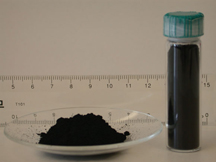| Choucair et al., report a bottom-up chemical method to directly synthesize graphene sheets in gram quantities. This technique is based on the laboratory reagents ethanol and sodium, which are reacted to give an intermediate solid that is then pyrolized, yielding a fused array of graphene sheets that can be dispersed subsequently by mild sonication and dried to produce graphene powder. |
Reviewed by Mark Tuominen, Director of the National Nanomanufacturing Network and Professor of Physics at the University of Massachusetts Amherst
Graphene—the two-dimensional sheet form of carbon—exhibits remarkable properties, including an electron mobility in excess of 200,000 cm2V-1s-1, suggesting promising applications in electronics, energy, sensors, composites and more. However, most previous work has produced graphene from bulk highly-oriented pyrolitic graphite by micromechanical cleavage or other “delamination” methods, typically producing quantities too small for nanomanufacturing. The ability to produce large quantities of graphene from nongraphitic precursors with a scalable, low-cost approach is a significant step towards real-world applications of graphene.

The definitive evidence that the carbon sheets obtained by this method are only a single atomic layer thick was obtained with atomic force microscopy (AFM). Multiple cross-sections were recorded of the sample laid onto a mica substrate, and the step heights measured between the surface of the sheets and the substrate were consistently found to be 4 Angstrom, proving them to be only a single atom thick. Electron diffraction was used to verify that the carbon sheets are crystalline graphene. X-ray photoemission spectroscopy (XPS) showed the presence of a significant amount of sodium oxide in the pyrolysis product. However, washing the product with distilled water was effective in removing this impurity.
The synthesis method produces approximately 0.1 g of graphene per 1 ml of ethanol reactant. A typical synthesis run consists of heating a 1:1 molar ratio of sodium and ethanol in a sealed reactor vessel at 220 ˚C for 72 hours to yield the graphene precursor. This material is washed with deionized water and vacuum dried at 100 ˚C for 24 hours. 2 g of sodium and 5 ml of ethanol yields about 0.5 g of graphene. This work is a notable step towards large-scale nanomanufacturing of graphene. Creating pathways to scale-up, achieving uniform graphene crystallite size, and routes to compositing or integrating the material are a few representative issues that need to be addressed in future work.
Image reprinted by permission from Macmillan Publishers Ltd: M. Choucair, P. Thordarson and J.A. Stride, “Gram-scale production of graphene based on solvothermal synthesis and sonication,” Nature Nanotechnology 4, 30-33 (2009). Copyright 2008.
This work is licensed under a Creative Commons Attribution-NonCommercial-NoDerivs 3.0 Unported.
